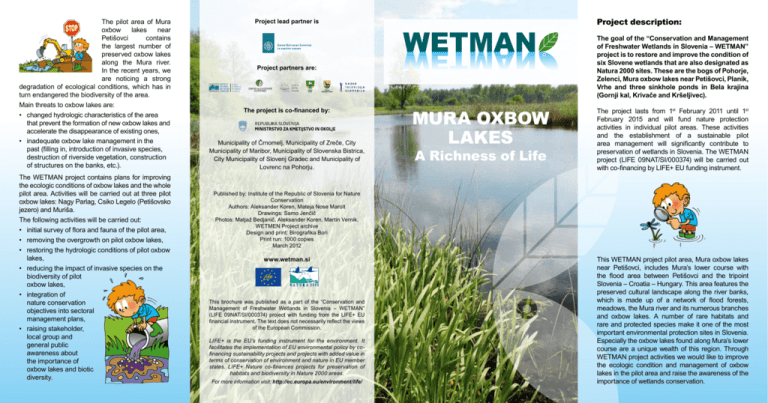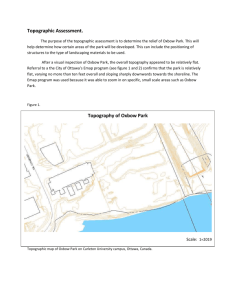mura oxbow lakes
advertisement

The pilot area of Mura oxbow lakes near Petišovci contains the largest number of preserved oxbow lakes along the Mura river. In the recent years, we are noticing a strong degradation of ecological conditions, which has in turn endangered the biodiversity of the area. Main threats to oxbow lakes are: • changed hydrologic characteristics of the area that prevent the formation of new oxbow lakes and accelerate the disappearance of existing ones, • inadequate oxbow lake management in the past (filling in, introduction of invasive species, destruction of riverside vegetation, construction of structures on the banks, etc.). The WETMAN project contains plans for improving the ecologic conditions of oxbow lakes and the whole pilot area. Activities will be carried out at three pilot oxbow lakes: Nagy Parlag, Csiko Legelo (Petišovsko jezero) and Muriša. The following activities will be carried out: • initial survey of flora and fauna of the pilot area, • removing the overgrowth on pilot oxbow lakes, • restoring the hydrologic conditions of pilot oxbow lakes, • reducing the impact of invasive species on the biodiversity of pilot oxbow lakes, • integration of nature conservation objectives into sectoral management plans, • raising stakeholder, local group and general public awareness about the importance of oxbow lakes and biotic diversity. Project description: Project lead partner is The goal of the “Conservation and Management of Freshwater Wetlands in Slovenia – WETMAN” project is to restore and improve the condition of six Slovene wetlands that are also designated as Natura 2000 sites. These are the bogs of Pohorje, Zelenci, Mura oxbow lakes near Petišovci, Planik, Vrhe and three sinkhole ponds in Bela krajina (Gornji kal, Krivače and Kršeljivec). Project partners are: The project is co-financed by: Municipality of Črnomelj, Municipality of Zreče, City Municipality of Maribor, Municipality of Slovenska Bistrica, City Municipality of Slovenj Gradec and Municipality of Lovrenc na Pohorju. MURA OXBOW LAKES A Richness of Life The project lasts from 1st February 2011 until 1st February 2015 and will fund nature protection activities in individual pilot areas. These activities and the establishment of a sustainable pilot area management will significantly contribute to preservation of wetlands in Slovenia. The WETMAN project (LIFE 09NAT/SI/000374) will be carried out with co-financing by LIFE+ EU funding instrument. Published by: Institute of the Republic of Slovenia for Nature Conservation Authors: Aleksander Koren, Mateja Nose Marolt Drawings: Samo Jenčič Photos: Matjaž Bedjanič, Aleksander Koren, Martin Vernik, WETMEN Project archive Design and print: Birografika Bori Print run: 1000 copies March 2012 www.wetman.si This brochure was published as a part of the “Conservation and Management of Freshwater Wetlands in Slovenia – WETMAN” (LIFE 09NAT/SI/000374) project with funding from the LIFE+ EU financial instrument. The text does not necessarily reflect the views of the European Commission. LIFE+ is the EU’s funding instrument for the environment. It facilitates the implementation of EU environmental policy by cofinancing sustainability projects and projects with added value in terms of conservation of environment and nature in EU member states. LIFE+ Nature co-finances projects for preservation of habitats and biodiversity in Nature 2000 areas. For more information visit: http://ec.europa.eu/environment/life/ This WETMAN project pilot area, Mura oxbow lakes near Petišovci, includes Mura’s lower course with the flood area between Petišovci and the tripoint Slovenia – Croatia – Hungary. This area features the preserved cultural landscape along the river banks, which is made up of a network of flood forests, meadows, the Mura river and its numerous branches and oxbow lakes. A number of rare habitats and rare and protected species make it one of the most important environmental protection sites in Slovenia. Especially the oxbow lakes found along Mura’s lower course are a unique wealth of this region. Through WETMAN project activities we would like to improve the ecologic condition and management of oxbow lakes in the pilot area and raise the awareness of the importance of wetlands conservation. DOF2006: Source GURS Floating fern Green hawker Moor frog Mura is Slovenia’s largest lowland river. Once a strongly meandering river that would often change its course is now for the most part tame and straight. Its primeval, natural image can nowadays only be admired in certain places along its lower course. The natural process of changing and shaping its course and riverbed, the preserved natural elements and the habitat diversity make this region an important nature protection site. Floating fern is a species of aquatic fern that can in Slovenia only be found in a few oxbow lakes along Mura’s lower course. The endangered green hawker dragonfly only thrives in those few oxbow lakes where the equally endangered and rare water soldier grows. Green hawker can only be found in the vicinity of Petišovci. The moor frog male changes its colour to blue in spring during the spawning season. Endeavours for preservation of Mura and its natural treasures date back for several decades. The nature protection importance of this area is emphasized by its designation as a Nature 2000 area of ecological importance, numerous natural values and the proposal for establishing a Mura regional park. The whole area is also a part of the emerging international Biosphere Reserve Mura – Drava - Donava. Oxbow lakes are typical of lowland rivers. Their formation, existence and disappearance are related to the natural river dynamics, which can be seen in constant changes of the river’s course - meandering. An oxbow lake forms from a river bend or from a branch. The river erodes the outer banks, which Murska šuma to disappear. Accumulation of material during floods, deposition of organic plant remains and dust particles slowly fill up the waterhole. The natural process of formation and disappearance can last several decades. Human interference with Mura’s stream has significantly decreased the chance of new oxbow lake formation and accelerated the process of their disappearance. Diagram of oxbow lake formation causes the bend to grow, bringing its beginning and end closer together. In time the water erodes the banks so far that it creates a new course along the shorter path. The beginning and the end of the bend slowly become filled with material and an oxbow lake without a contact with running water is created. An oxbow lake can also be formed from a branch, when the branch loses its connection with the main riverbed. Despite that, Mura oxbow lakes are full of life and a paradise for numerous animal and plant species. The water is full of insects, beetles, crabs, water bugs, snails, leeches and other small creatures. Some of them also spend parts of their adult lives above water. One such example are dragonflies, of which over 30 different species can be found along Mura’s oxbow lakes. species use oxbow lakes as spawning grounds. Oxbow lakes are also home to the European pond turtle, otter and beaver, and the nesting place for numerous bird species. The flora of oxbow lakes is also rich and interesting, it depends on the inflow of water, their depth and their exposure to the sun. Among the most typical plants that grow in oxbow lakes are the European white water-lily, its cousin, the yellow water-lily, the frogbit, various pondweeds, watermilfoils, hornwort and duckweed. Upon their creation, oxbow lakes are already doomed Oxbow lakes are also home to a number of fish species. The most special and endangered among them is the European mudminnow. At least ten different amphibian Rootless duckweed, the arrowhead, the water soldier, the bladderwort, the flowering rush and the floating fern are among the many endangered and rare plant species growing in oxbow lakes. Murska šuma Muriša Oxbow lake with a water soldier









